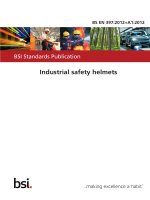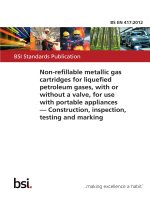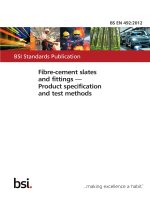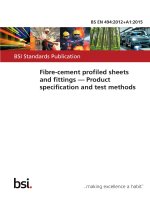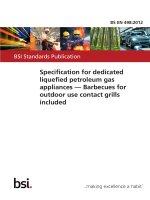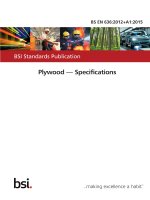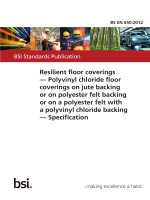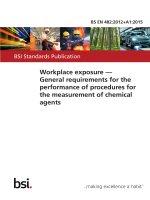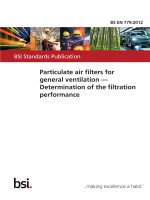Bsi bs en 62023 2012
Bạn đang xem bản rút gọn của tài liệu. Xem và tải ngay bản đầy đủ của tài liệu tại đây (1.64 MB, 36 trang )
BS EN 62023:2012
BSI Standards Publication
Structuring of technical
information and
documentation
NO COPYING WITHOUT BSI PERMISSION EXCEPT AS PERMITTED BY COPYRIGHT LAW
raising standards worldwide™
BRITISH STANDARD
BS EN 62023:2012
National foreword
This British Standard is the UK implementation of EN 62023:2012. It is
identical to IEC 62023:2011, incorporating corrigendum February 2012.
It supersedes BS EN 62023:2001 which is withdrawn.
The UK participation in its preparation was entrusted to Technical Committee
GEL/3, Documentation and graphical symbols.
A list of organizations represented on this committee can be obtained on
request to its secretary.
This publication does not purport to include all the necessary provisions of a
contract. Users are responsible for its correct
application. © The British Standards Institution 2012
Published by BSI Standards Limited 2012
ISBN 978 0 580 62096 6
ICS 01.110; 29.020
Compliance with a British Standard cannot confer immunity from
legal obligations.
This British Standard was published under the authority of the
Standards Policy and Strategy Committee on 31 May 2012.
Amendments/corrigenda issued since publication
Date
Text affected
EUROPEAN STANDARD
EN 62023
NORME EUROPÉENNE
January 2012
EUROPÄISCHE NORM
ICS 29.020
Supersedes EN 62023:2000
Incorporating corrigendum February 2012
English version
Structuring of technical information and documentation
(IEC 62023:2011)
Structuration des informations et de la
documentation techniques
(CEI 62023:2011)
Strukturierung technischer Information
und Dokumentation
(IEC 62023:2011)
This European Standard was approved by CENELEC on 2011-11-23. CENELEC members are bound to comply
with the CEN/CENELEC Internal Regulations which stipulate the conditions for giving this European Standard
the status of a national standard without any alteration.
Up-to-date lists and bibliographical references concerning such national standards may be obtained on
application to the CEN-CENELEC Management Centre or to any CENELEC member.
This European Standard exists in three official versions (English, French, German). A version in any other
language made by translation under the responsibility of a CENELEC member into its own language and notified
to the CEN-CENELEC Management Centre has the same status as the official versions.
CENELEC members are the national electrotechnical committees of Austria, Belgium, Bulgaria, Croatia, Cyprus,
the Czech Republic, Denmark, Estonia, Finland, France, Germany, Greece, Hungary, Iceland, Ireland, Italy,
Latvia, Lithuania, Luxembourg, Malta, the Netherlands, Norway, Poland, Portugal, Romania, Slovakia, Slovenia,
Spain, Sweden, Switzerland, Turkey and the United Kingdom.
CENELEC
European Committee for Electrotechnical Standardization
Comité Européen de Normalisation Electrotechnique
Europäisches Komitee für Elektrotechnische Normung
Management Centre: Avenue Marnix 17, B - 1000 Brussels
© 2012 CENELEC -
All rights of exploitation in any form and by any means reserved worldwide for CENELEC members.
Ref. No. EN 62023:2012 E
BS EN 62023:2012
EN 62023:2012 (E)
–2–
Foreword
The text of document 3/1050/FDIS, future edition 2 of IEC 62023, prepared by IEC/TC 3 "Information
structures, documentation and graphical symbols" was submitted to the IEC-CENELEC parallel vote and
approved by CENELEC as EN 62023:2012.
The following dates are fixed:
•
•
latest date by which the document has
to be implemented at national level by
publication of an identical national
standard or by endorsement
latest date by which the national
standards conflicting with the
document have to be withdrawn
(dop)
2012-08-23
(dow)
2014-11-23
This document supersedes EN 62023:2000.
EN 62023:2011 includes the following significant technical changes with respect to EN 62023:2000:
— the terminology used in the publication has been adapted to the one used in EN 81346-1:2009 and
EN 62507-1:2011;
— the figures have been adapted to the principles used in EN 81346-1:2009 in order to better illustrate
the interrelations between the standards;
— the examples in the annexes have been provided with comments;
Attention is drawn to the possibility that some of the elements of this document may be the subject of
patent rights. CENELEC [and/or CEN] shall not be held responsible for identifying any or all such patent
rights.
Endorsement notice
The text of the International Standard IEC 62023:2011 was approved by CENELEC as a European
Standard without any modification.
In the official version, for Bibliography, the following notes have to be added for the standards indicated:
IEC 62507-1:2010
NOTE Harmonized as EN 62507-1:2011 (not modified).
IEC 81346-2:2009
NOTE Harmonized as EN 81346-2:2009 (not modified).
BS EN 62023:2012
EN 62023:2012 (E)
–3–
Annex ZA
(normative)
Normative references to international publications
with their corresponding European publications
The following referenced documents are indispensable for the application of this document. For dated
references, only the edition cited applies. For undated references, the latest edition of the referenced
document (including any amendments) applies.
NOTE When an international publication has been modified by common modifications, indicated by (mod), the relevant EN/HD
applies.
Publication
Year
Title
EN/HD
Year
IEC 61082-1
2006
Preparation of documents used in
electrotechnology Part 1: Rules
EN 61082-1
2006
IEC 61355-1
2008
Classification and designation of documents
for plants, systems and equipment Part 1: Rules and classification tables
EN 61355-1
2008
IEC 61360
-
Component data dictionary (CDD)
-
-
IEC 62027
-
Preparation of object lists,
including parts lists
EN 62027
-
IEC/PAS 62569-1
-
Generic specification of information on
products Part 1: Principles and methods
-
-
IEC 81346-1
2009
Industrial systems, installations and
equipment and industrial products Structuring principles and reference
designations Part 1: Basic rules
EN 81346-1
2009
IEC 82045-1
2001
Document management Part 1: Principles and methods
EN 82045-1
2001
IEC 82045-2
2004
Document management Part 2: Metadata elements and information
reference model
EN 82045-2
2005
ISO 7200
-
Technical product documentation Data fields in title blocks and document
headers
EN ISO 7200
-
BS EN 62023:2012
EN 62023:2012 (E)
–4–
CONTENTS
INTRODUCTION ..................................................................................................................... 6
1
Scope ............................................................................................................................... 7
2
Normative references ....................................................................................................... 7
3
Terms and definitions ....................................................................................................... 7
4
3.1 General terms ......................................................................................................... 8
3.2 Terms related to documentation structure .............................................................. 10
3.3 Terms related to document structure ..................................................................... 11
3.4 Alphabetical index of terms ................................................................................... 12
General .......................................................................................................................... 12
4.1
4.2
4.3
5
Basic principles of structuring of systems, installations and products..................... 12
Objects and documents describing the objects ...................................................... 14
Documentation structure and document structure .................................................. 14
4.3.1 Documentation structure ............................................................................ 14
4.3.2 Document structure ................................................................................... 14
4.3.3 Border between documentation structure and document structure ............. 15
Main document and complementary documents .............................................................. 15
5.1
5.2
6
General ................................................................................................................. 15
Contents of the main document ............................................................................. 16
5.2.1 Document parts ......................................................................................... 16
5.2.2 Document part containing complementary documents ............................... 17
5.2.3 Document part containing characteristic properties .................................... 17
5.2.4 Document part containing constituent objects ............................................ 17
5.3 Relationship between main document and complementary documents .................. 18
5.3.1 Main document .......................................................................................... 18
5.3.2 Complementary documents ....................................................................... 18
5.4 Single-level and multi-level main documents ......................................................... 19
5.5 Classification of the main document ...................................................................... 20
Representations of an object .......................................................................................... 20
6.1 General ................................................................................................................. 20
6.2 Presentation of an object type at its occurrences ................................................... 20
6.3 Referencing ........................................................................................................... 21
6.4 Document metadata .............................................................................................. 21
Annex A (informative) Example of a composite main document based on a parts list
document .............................................................................................................................. 24
Annex B (informative) Example of a main document based on a list of documents,
referencing data sheet, object lists, etc. ................................................................................ 26
Bibliography .......................................................................................................................... 31
Figure 1 – Illustration of an object with three aspects, and where each of these aspects
are used for sub-structuring .................................................................................................. 13
Figure 2 – Information content of a document describing an object ....................................... 15
Figure 3 – Documentation structure for a single object .......................................................... 16
–5–
BS EN 62023:2012
EN 62023:2012 (E)
Figure 4 – Main document and complementary documents; illustration of different
degrees of partitioning of the information into different documents ........................................ 19
Figure 5 – Relations among objects and documents ............................................................. 23
BS EN 62023:2012
EN 62023:2012 (E)
–6–
INTRODUCTION
IEC 62023 can be seen as a bridge between system structuring principles and documentation
structuring principles, in that it provides:
•
a standardization of common practice in manufacturing industry with regard to the
organization of information / documentation according to the product structure by means
of a main document;
•
a further detailing and formalization of guidance already given in IEC 61355-1:2008, by
the general establishment of the main document concept with explicit referencing to
complementary documents in a document set for a technical object; and
•
an application of the object concept from the structuring principles of IEC 81346-1:2009 in
the area of document structuring. It goes beyond the existing documents in that it shows
how objects with several aspects can be kept together in a systematic way.
In Product Data Management (PDM) systems the ”objects” in the product structure, which are
configuration controlled information objects, correspond logically to main documents.
However, although they fulfil all necessary requirements for being documents, the term is
sometimes not used for them.
–7–
BS EN 62023:2012
EN 62023:2012 (E)
STRUCTURING OF TECHNICAL INFORMATION
AND DOCUMENTATION
1
Scope
This international standard provides rules for applying a method of structuring technical
information and documentation by using a main document (leading document) for the
clustering of the information for each object.
2
Normative references
The following referenced documents are indispensable for the application of this document.
For dated references, only the edition cited applies. For undated references, the latest edition
of the referenced document (including any amendments) applies.
IEC 61082-1:2006, Preparation of documents used in electrotechnology – Part 1: Rules
IEC 61355-1:2008, Classification and designation of documents for plants, systems and
equipment – Part 1: Rules and classification tables
IEC 61360, Component data dictionary (CDD).
Available from: < />IEC 62027: -, Preparation of object lists, including parts lists 1
IEC/PAS 62569-1, Generic specification of information on products – Part 1: Principles and
methods
IEC 81346-1:2009, Industrial systems, installations and equipment and industrial products Structuring principles and reference designations – Part 1: Basic rules
IEC 82045-1:2001, Document management – Part 1: Part 1: Principles and methods
IEC 82045-2:2004, Document management – Part 2: Metadata elements and information
reference model
ISO 7200, Technical product documentation – Data fields in title blocks and document
headers
3
Terms and definitions
For the purposes of this document, the following terms and definitions apply. In the
definitions, terms that are defined elsewhere in this clause are shown in italics.
An alphabetical index of terms is given in 3.4.
NOTE Definitions taken over from other international standards are not necessarily literally cited, but adapted to
the form required for definitions according to the ISO/IEC Directives.
—————————
1 In preparation.
BS EN 62023:2012
EN 62023:2012 (E)
3.1
–8–
General terms
3.1.1
object
entity treated in a process of development, implementation, usage and disposal
NOTE 1
exist.
The object may refer to a physical or non-physical “thing”, i.e. anything that might exist, exists or did
NOTE 2
The object has information associated to it.
[IEC 81346-1:2009, definition 3.1]
3.1.2
system
set of interrelated objects considered in a defined context as a whole and separated from their
environment
NOTE 1 The system is considered to be separated from the environment and from the other external systems by
an imaginary surface, which cuts the links between them and the system.
NOTE 2
A system is generally defined with a view to achieve a given objective.
NOTE 3
The term system should be qualified if it is not clear from the context to what it refers.
Examples of a system: a drive system, a water supply system, a stereo system, a computer.
NOTE 4
When a system is part of another system, it may be considered as an object.
[IEC 351-21-20, modified]
3.1.3
plant
assembly of different systems on a specific site
[IEC 61355-1:2008, definition 3.10]
3.1.4
aspect
specified way of viewing an object
[IEC 81346-1:2009, definition 3.3]
3.1.5
structure
organization of relations among objects of a system describing constituency relations
(consists of/is a part of)
[IEC 81346-1:2009, definition 3.9]
3.1.6
occurrence (of an object)
use of an object type within a specified context (another object or system) irrespective of
which object individual is being used
[IEC 62507, definition 3.15]
3.1.7
identifier
attribute associated with an object to unambiguously identify it in a specified domain
NOTE
In an identification system several types of identifiers may be required.
[IEC 62507-1, definition 3.8]
–9–
BS EN 62023:2012
EN 62023:2012 (E)
3.1.8
identification number
ID
string of characters representing the value of the identifier
NOTE 1
well.
It is practice that although the term says “number” the string can contain other types of characters as
NOTE 2 The terms product number, item number; part number; article number; product identifying number,
traceability number (serial or batch) are sometimes used as synonyms to identification number.
NOTE 3 Identification numbers are often required to be unique (an object shall have one number only). This is an
unnecessary strong requirement, it is sufficient if they are unambiguous. An object may have more than one
identification number, even if this is an undesirable situation.
Furthermore, it is assumed in the definition that an organization may be responsible for more than one
identification number domain. This is a commonly occurring situation when organizations are merged, etc.
NOTE 4 For products, identification number is normally assigned at the engineering of the object. Objects with the
same identification number are supposed to have the same “form, fit and function” and hence being
interchangeable.
[IEC 62507-1, definition 3.5, modified]
3.1.9
identification (activity)
act of associating identification numbers to an object
[IEC 62507-1, definition 3.4]
3.1.10
product number
product ID
part number
part ID
identification number of a product, based on an identification system used by a particular
organization
NOTE The term part is often synonym for a product that is expected to be used as a component of one or more
assembled products. Part number is therefore synonym to product number.
3.1.11
reference designation
identifier of a specific object formed with respect to the system of which the object is a
constituent, based on one or more aspects of that system
[IEC 81346-1:2009, definition 3.11]
3.1.12
reference designation set
collection of two or more reference designations assigned to an object of which at least one
unambiguously identifies this object
[IEC 81346-1:2009, definition 3.14]
3.1.13
type (of object)
class of objects having the same set of characteristic properties
[IEC 62507-1, definition 3.16]
BS EN 62023:2012
EN 62023:2012 (E)
3.2
– 10 –
Terms related to documentation structure
3.2.1
document
fixed and structured amount of information that can be managed and interchanged as a unit
between users and systems
NOTE 1
This unit may not necessarily be human perceptible. Information is usually stored on a data medium.
NOTE 2
The term document is not restricted to its meaning in a legal sense.
NOTE 3 A document can be designated in accordance with the type of information and the form of presentation,
for example overview diagram, connection table, function chart.
[IEC 61082-1:2006, definition 3.1.2 and IEC 82045-1:2001, definition 3.2.3, modified]
3.2.2
document number
document ID
identification number assigned to a document
[based on IEC 82045-2:2004, <documentId> (Clause 8)]
3.2.3
documentation (noun)
collection of documents related to a given subject
NOTE 1
This may include technical, commercial and/or other documents.
NOTE 2
The term subject may refer to objects in the sense of IEC 81346 or to other things to be addressed.
NOTE 3
A documentation can consist of documents, composite documents and document sets.
NOTE 4
The number and kinds of documents in a documentation can differ according to purpose.
[IEC 61355-1:2008, definition 3.5]
3.2.4
document set
collection of different documents which is intended to be treated as a unit
NOTE
Document sets may consist of documents and composite documents.
[IEC 61355-1:2008, definition 3.4]
3.2.5
main document
leading document
document representing an object and containing or referring to the complete information on
the object
3.2.6
single-level main document
main document that specifies one assembly level of sub-objects only
3.2.7
multi-level main document
main document that specifies more than one assembly level of sub-objects
3.2.8
complementary document
supplementary document
referenced document, containing part of the information on an object
– 11 –
BS EN 62023:2012
EN 62023:2012 (E)
NOTE Complementary documents may carry the detailed information, while the main document may carry
information on the organization of the complementary documents only. Example: drawings can be complementary
documents to object lists.
3.2.9
document kind
type of document defined with respect to its specified content of information and form of
presentation
NOTE
Sometimes the term document type is used for the same concept.
[IEC 61355-1:2008, definition 3.6]
3.2.10
document kind class
group of document kinds having similar characteristics concerning content of information
independent from the form of presentation.
[IEC 61355-1:2008, definition 3.7]
3.3
Terms related to document structure
3.3.1
document part
identifiable part of a document having a defined purpose with respect to the document
NOTE The concept of document parts emanates from the observation that a document can be sub-divided into
parts, logically and/or physically. A logical part presents information in a homogeneous form of presentation.
Examples of such parts are: administrative part, part containing characteristic properties, part containing
complementary documents, drawing part, revision part, and document header. Example of physical parts: page,
text block, figure, or, considering other media than paper: diskette.
3.3.2
composite document
document containing different parts of information, each part related to a different document
kind class
[IEC 61355-1:2008, definition 3.3]
3.3.3
list item
presentation as part of a table or list of an ordered set of characteristic property values
pertaining to one specific object
[IEC 62027:--, definition 3.3.1]
3.3.4
document list body
table containing list items specifying documents
3.3.5
object list body
table containing list items specifying the objects that constitute an assembly (or subassembly) or system and, if necessary, reference documents
[IEC 62027:--, definition 3.3.2]
BS EN 62023:2012
EN 62023:2012 (E)
3.4
– 12 –
Alphabetical index of terms
Term
Term number
Term
Term number
aspect
3.1.4
main document
3.2.5
complementary document
3.2.8
multi-level main document
3.2.7
composite document
3.3.2
object
3.1.1
document
3.2.1
object list body
3.3.5
document ID
3.2.2
occurrence
3.1.6
document kind
3.2.9
part ID
3.1.10
document kind class
3.2.10
part number
3.1.10
document list body
3.3.4
plant
3.1.3
document number
3.2.2
product ID
3.1.10
document part
3.3.1
product number
3.1.10
document set
3.2.4
reference designation
3.1.11
documentation (noun)
3.2.3
reference designation set
3.1.12
ID
3.1.9
single-level main document
3.2.6
identification
3.1.9
structure
3.1.5
identification number
3.1.8
supplementary document
3.3.2
identifier
3.1.7
system
3.1.2
leading document
3.2.5
type
3.1.14
list item
3.3.3
4
4.1
General
Basic principles of structuring of systems, installations and products
In order to design, manufacture, operate and maintain systems, installations or products
efficiently, these are usually divided into parts or objects. The establishing of objects and the
organization of the relations among them is called structuring, and the result a structure.
In accordance with IEC 81346-1:2009 different structures can be recognized depending on
the aspect, for example:
•
a function-oriented structure;
•
a product-oriented structure;
•
a location-oriented structure.
Other structures may be relevant for certain purposes.
Each structure is formed in a tree-like, hierarchical way as shown in Figure 1. In such
structures a node represents an object that is of interest from the chosen aspect. It is divided
into its constituents, lower-level objects, as indicated by the branches. These constituent
parts can in turn be divided into their constituent branches etc.
BS EN 62023:2012
EN 62023:2012 (E)
– 13 –
Object
<top node>
Product aspect
(-)
Location aspect
(+)
Product-oriented
structure
Function aspect
(=)
Branch
Sub-objects in
location aspect
Sub-objects in
product aspect
-1
+1
=1
Node
-2
+1+1
Sub-objects in
function aspect
Location-oriented
structure
=2
+1+2
Function-oriented
structure
=2=1
+1+2+1
+2
=2=2
+1+2+2
IEC
2140/11
Figure 1 – Illustration of an object with three aspects,
and where each of these aspects are used for sub-structuring
The different structures suit different working tasks:
•
a function-oriented structure is based on the purpose of a system. A function-oriented
structure shows the subdivision of the system into constituent objects with respect to the
function aspect, without taking into account possible location and/or product aspects of
these objects;
NOTE 1 Documents in which the information on a system is organized in accordance with a function-oriented
structure highlight the functional relations among the components of that system.
•
a product-oriented structure is based on the way a system is implemented, constructed or
delivered using intermediate or final components. A product-oriented structure shows the
subdivision of the system into constituent objects with respect to the product aspect
without taking into account possible function and/or location aspects of these objects;
NOTE 2 Documents in which the information on a system is organized in accordance with a product-oriented
structure highlight the physical arrangements of the components of that system.
•
a location-oriented structure is based on the topographical layout or the spatial
constituents of an object. A location-oriented structure shows the subdivision of the
system into constituent objects with respect to the location aspect without taking into
account possible product and/or function aspects of these objects.
NOTE 3 Documents in which the information on a system is organized in accordance with a location-oriented
structure highlight the topographical relations among the components of that system.
For further information on structuring, see IEC 81346-1:2009.
BS EN 62023:2012
EN 62023:2012 (E)
4.2
– 14 –
Objects and documents describing the objects
A number of different ways of producing, presenting, storing and distributing information about
objects exist.
Computers make it easy to process a set of information as a coherent unit, in principle
regardless of volume. Outside of the computer system, this set of information has usually to
be divided into subsets of information for transfer to other systems and for presentation via
other media.
Traditional practice is to work with limited subsets of information in the form of documents, a
concept that is also used in connection with computer-stored information and has therefore
acquired the generalized definition of a structured set of information capable of being
processed and exchanged as a unit between users and/or systems.
4.3
Documentation structure and document structure
4.3.1
Documentation structure
The documentation structure describes how the total amount of information about a plant,
system, product, etc. is split up among different documents and the relations among these
documents.
A documentation structure that takes advantage of the object concept very precisely reflects
the structure of the actual plant, system, equipment or product. The defined documents shall
then be associated to the object as a whole or to the identified sub-objects. A defined
document should not deal with anything outside of the relevant object or sub-object.
NOTE This does not prohibit that a document in such a set of documentation also can be used (by reference) to
give information on another object, provided that it as a whole is relevant also in that context.
Sets of documentation thus defined can then be manipulated as a whole in order to fit into
different contexts, which is a necessary prerequisite for efficient re-use of information.
4.3.2
Document structure
The document structure describes how the information within a specific document is split up in
different document parts and the relations among these parts.
A document part is a sub-information-object which has an existence of its own and is
characterized in that it:
–
has a coherent form of presentation (e.g. text, drawing, etc so that it can be manipulated
with one tool); or
–
deals with a specific subject (e.g. chapters and clauses in a text, see also Figure 2); or
–
presents a specific sub-object (e.g. instance diagrams in a circuit diagram); or
–
forms a physical (layout) block (e.g. a page or an illustration that must be kept together on
one page);
–
etc.
A document part is identifiable and it is possible to manage this part like a document as a
whole.
A document part can consist of other document parts. The document parts are thus possible
to be organized in a consist-of/is-part-of document structure. Such a structure is always
inherent in a composite document.
– 15 –
BS EN 62023:2012
EN 62023:2012 (E)
What is it?
Prepared by whom, when and
where?
Consists of what and how?
What happened, when and why?
IEC
2141/11
Figure 2 – Information content of a document describing an object
4.3.3
Border between documentation structure and document structure
The border between documentation structure and document structure is arbitrary and based
on a decision on which sets of information are required to be presented as one document for
reasons of e.g. tradition, target group, reusability and available tools.
NOTE In the context of the tools used for the preparation of documents, the document parts are often managed in
a way similar to that for the management of documents.
As an example the documentation for an object can be implemented either as a set of
documents, each with a coherent form of presentation, or as one single composite document
in which each of these forms of presentation is dealt with as a document part (see Figure 4).
5
5.1
Main document and complementary documents
General
The information to be provided for an object shall be clearly related to this object.
This information is, when presented, normally split on several documents. To ensure that the
information can nevertheless be kept together, one of the documents is depicted main
document (alternative term "leading document"), the others being complementary documents
(see Figure 3).
BS EN 62023:2012
EN 62023:2012 (E)
– 16 –
Main document
Complementary documents
| Property| Qualifier| DET| Value| Unit|
| Property| Qualifier| DET| Value| Unit|
| Property| Qualifier| DET| Value| Unit|
|Dimension drawing
|Circuit diagram
|Connection table
|9XYZ 1002|
|9XYZ 1003|
|9XYZ 1004|
|Ref des|Name|Type des|Data|Part ID|
|Ref des|Name|Type des|Data|Part ID|
|Ref des|Name|Type des|Data|Part ID|
|Ref des|Name|Type des|Data|Part ID|
Object list | 9XYZ 1001
| 9XYZ 1002
| 9XYZ 1003
| 9XYZ 1004
IEC
2142/11
Figure 3 – Documentation structure for a single object
The main document then represents the complete technical object and is characterized by the
following features:
•
it shall have a close relation to the technical object described (for example: part number
and document number are the same or closely related, or: document designation that
includes object designation (e.g. reference designation including top node identification));
and
•
it should refer to all complementary documents, either directly or indirectly via a separate
document list.
Complementary documents should not refer back to the main document.
NOTE 1 If complementary documents are used together with different main documents, references back creates
an immense demand for updating of the complementary documents.
It is thus always possible to refer to the complete set of information by means of the part
number (in the context of the issuing organization), or by the top node identifier, or by the
reference designation that identifies the object (in the context of the system, product, etc.). It
is also possible to refer to and to use the same complementary documents for a number of
similar objects.
NOTE 2 As the references to the complementary documents are made explicitly, there is no need for any
systematic in document numbering, etc.
NOTE 3 In Product Data Management (PDM) systems the “objects” (in the product-oriented structure) which are
configuration controlled information objects, correspond logically to main documents. However, although they fulfil
all necessary requirements for being documents, they are sometimes not considered as documents.
5.2
Contents of the main document
5.2.1
Document parts
The main document shall contain an administrative part and a part listing the complementary
documents (”document list body”), or refer to such a list. It may in addition contain:
•
a part containing characteristic properties of the object (“property list body”);
– 17 –
•
BS EN 62023:2012
EN 62023:2012 (E)
a part listing the constituents of the object (”object list body”).
Annex A shows an example of a main document containing these parts.
For the administrative part, see IEC 82045-1:2001 and IEC 82045-2:2004 dealing with
document management.
5.2.2
Document part containing complementary documents
This part shall contain a list of the complementary documents.
The part should be prepared in the form of a ”document list body”, in which the document list
items specify documents by means of essential metadata for the documents in order to make
them unambiguously identified and traceable.
The following metadata is mandatory:
document ID <DocumentId>
The following metadata are optional:
•
language code <LanguageCode>
•
revision index <DocumentRevisionId>
•
document kind code <DocumentClassIdIEC61355>
•
document kind <DocumentClassName>
•
title <Title>
These metadata are further specified in IEC 82045-2:2004, from which the metadata
identifiers shown within angle brackets (< >) have been taken.
5.2.3
Document part containing characteristic properties
This part shall contain a specification or description of the object by means of its
characteristic properties.
The part should be prepared in the form of a “property list body” in which the properties are
specified by means of essential metadata for the properties in order to make them
unambiguously identified and traceable. Use should preferably be made of relevant data
element type definitions in international standards such as IEC 61360 and ISO 13584.
The values of the properties are normally associated with a specific life cycle phase of the
object, for example “as supplied”, i.e. the property values as manufactured and supplied to
the customer.
If values associated with several life cycle phases are supplied, the properties shall be
individually qualified. For further information, see IEC/PAS 62569-1. See also example in
Annex A.
5.2.4
Document part containing constituent objects
This document part shall contain a list of the sub-objects in accordance with the chosen
aspect.
The part should be prepared in the form of an “object list body”, in which the list items specify
sub-objects by means of essential metadata for the sub-objects in order to make them
unambiguously identified and traceable. For further information, see IEC 62027.
BS EN 62023:2012
EN 62023:2012 (E)
– 18 –
The method to include this document part in the main document makes it possible to trace the
sub-ordinate objects more easily than in any of the other methods, and therefore
recommended.
A main document can be used to specify an object from many aspects by inclusion of one
object list body for each relevant aspect. How this can be done is illustrated in the Annex A.
5.3
Relationship between main document and complementary documents
5.3.1
Main document
As a consequence of 5.2, main documents are commonly based on the following document
kinds:
•
single document, e.g. component drawing; in which the property list body is
predominant. This document kind is especially used for purchased components, specified
by means of a list of requested characteristic properties, sometimes supplemented by a
textual description or an illustration;
•
object list; see Figure 4b), in which the object list body is predominant. For more
information on object lists, including parts lists, see IEC 62027:--; or
•
list of documents; see Figure 4c), in which the document list body is predominant. The
scope of such a list is limited to the actual object.
NOTE Documents of the above kinds are not always main documents. The requirements with regard to
identification and referencing to the complementary documents have to be fulfilled as well.
A main document may also take the form of a single composite document containing the
whole set of information about the technical object concerned (see Figure 4a).
The opposite to that is the List of documents, with its scope limited to the actual object, and
listing all the documents that contain actual information, including the parts list document (see
Figure 4c).
5.3.2
Complementary documents
The complementary documents for an object are usually many and of different document
kinds. The type of object determines which document kinds need to be used.
BS EN 62023:2012
EN 62023:2012 (E)
– 19 –
Main document
Text text text text text. Text text text
text text. Text text text text text. Text
text text text text. Text text text text
text. Text text text text text. Text text
text text text.
Figure 4 a)
|Ref des|Name|Type des|Data|Part ID|
|Ref des|Name|Type des|Data|Part ID|
|Ref des|Name|Type des|Data|Part ID|
|Ref des|Name|Type des|Data|Part ID|
Component drawing | 9XYZ 1001
One single (composite) document
Complementary documents
Main document
|Dimension drawing
|Circuit diagram
|Connection table
|9XYZ 1002|
|9XYZ 1003|
|9XYZ 1004|
|Ref des|Name|Type des|Data|Part ID|
|Ref des|Name|Type des|Data|Part ID|
|Ref des|Name|Type des|Data|Part ID|
|Ref des|Name|Type des|Data|Part ID|
| 9XYZ 1002
Object list | 9XYZ 1001
| 9XYZ 1003
| 9XYZ 1004
Complementary documents
Main document
Figure 4 c)
|Object list
|9XYZ 1001|
|Dimension drawing
|Circuit diagram
|Connection table
|9XYZ 1002|
|9XYZ 1003|
|9XYZ 1004|
List of doc | 9XYZ 1005
List of documents
|Ref des|Name|Type des|Data|Part ID|
|Ref des|Name|Type des|Data|Part ID|
|Ref des|Name|Type des|Data|Part ID|
|Ref des|Name|Type des|Data|Part ID|
Object list | 9XYZ 1001
| 9XYZ 1002
| 9XYZ 1003
| 9XYZ 1004
IEC
2143/11
Figure 4a) The complete information is available in one single (composite) document, which therefore is the
main document.
Figure 4b) The complete information is available in a set of documents. The main document is an Object list /
Parts list that specifies constituents and all complementary documents
Figure 4c) The complete information is available in a set of documents. The main document is a List of
documents that specifies all complementary documents, including an Object list / Parts list.
Figure 4 – Main document and complementary documents; illustration of different
degrees of partitioning of the information into different documents
5.4
Single-level and multi-level main documents
In the design and engineering process the defined structures normally contain objects on
many structural levels.
BS EN 62023:2012
EN 62023:2012 (E)
– 20 –
In many cases, especially in engineering for manufacturing of products, the documentation is
prepared object-by-object, with single-level main documents, i.e. main documents that specify
the next sub-ordinate structure level only.
In other cases, especially in plant engineering, documentation may cover many objects, with a
multi-level main document, i.e. a main document that specifies sub-objects relating to more
than one sub-ordinate structural level. This may be the case if there is no need to identify (by
means of a part number or document number) a sub-ordinate object outside of the context of
the main document (i.e. to identify it as a generally usable type).
5.5
Classification of the main document
If the document kind classification system according to IEC 61355-1:2008 is applied then the
main documents should be classified as belonging to class AB (i.e. Lists (regarding
documents), according to Table A.2 - DCC and description of document kind classes),
irrespective of what document kind it is based on, since its role of being a main document is
dominating with respect to document administration.
NOTE In a document set for an object the main document should preferably precede all complementary
documents. If the document classification system according to IEC 61355-1:2008 is applied, the documents are
normally alphabetically sorted with regard to the document classification code. Code AB will therefore bring the
main document to the top and place it directly after a possible cover sheet.
6
6.1
Representations of an object
General
Two measures make it possible to apply the same documentation principles for plants,
systems and products, whatever their extent:
•
systematic structuring in accordance with IEC 81346-1:2009, with the aim to define and
identify objects; and
•
for each such object clustering of the information by means of a main document, as
described in Clause 5.
A documented object type may thus be referenced as a whole by a reference to the main
document.
Figure 5 illustrates the principle of the resulting documentation structure with objects arranged
in a tree-like structure, and the documents pertaining to each object. Each of the objects in
this example is composed as in Figure 3. The arrows pointing to the “common document
resource” to the left illustrate the multiple use of complementary documents.
In order to facilitate reuse of documentation associated with an object type, the following
items should be considered carefully in the preparation of documents:
•
Presentation of an object type at its occurrences, see 6.2;
•
Referencing from the object occurrences to the documentation associated with the object
type, see 6.3;
•
Metadata to be presented in the identification area of documents, see 6.4.
6.2
Presentation of an object type at its occurrences
In hierarchically structured documentation a sub-object shall be represented in the
documentation of the object on the next higher structural level, where the occurrence of the
sub-object is put in a context together with other sub-objects presented on that level. If the
higher level object is documented by several document kinds, the sub-object will usually need
to be represented in more than one of these documents.
– 21 –
BS EN 62023:2012
EN 62023:2012 (E)
The required representation of the occurrence of the sub-object depends of the form of
presentation used in each of these document kinds. The general requirement on such a
representation is that it shall be as simplified as possible, but still provide enough detail for
documentation of all relevant interfaces to other sub-objects.
The following examples illustrate this principle:
•
•
•
in object lists; the list item should contain:
–
occurrence (reference designation);
–
type (type designation or part number); and where necessary also
–
properties (the most relevant properties in the actual context).
in diagrams: representation of the object by an instance diagram or by a symbol,
presenting:
–
occurrence (reference designation);
–
the type designation or main document of the object; and
–
its reference designation; and
–
the terminals and electrical or other connections to it.
in drawings: representation of the object type by an instance drawing (simplified pictorial
drawing, dimension drawing), presenting:
–
occurrence (reference designation);
–
the type designation or main document of the object; and
–
its reference designation; and
–
the physical dimensions and the physical interface to other parts.
For further information on how to prepare list items for object lists, including parts lists, see
IEC 62027.
For further information on the use of instance diagrams and symbols in diagrams, see
IEC 61082-1:-, Clause 11.
For further information on the use of instance drawings, see ISO/DIS 29845 (e.g. interface
drawing, outline drawing)
6.3
Referencing
When object occurrences are shown in a document, it is necessary to provide mechanisms in
order to easily get to the detailed description of the corresponding object type. If the
documentation is following the principles laid down in this standard, the reference from the
object occurrence representation to the object type documentation may be performed by
means of the main document associated with the object occurrence.
NOTE This mechanism can be supplemented with a direct reference from the object occurrence to the relevant
object type document. Object type documents should not refer to occurrences.
6.4
Document metadata
Documents shall be associated with metadata in accordance with IEC 82045-1:2001 and
IEC 82045-2:2004. Some of these data are presented in the identification area of the
document (i.e. the title block, see ISO 7200).
Metadata of documents associated with an object type shall only be related to that object
type. No references shall be made to objects external to the object type or to occurrences of
the object type.
BS EN 62023:2012
EN 62023:2012 (E)
– 22 –
NOTE It is important to notice that any reference designations occurring in the documents refer to the described
object as the top node of its tree-like structures.
Circuit diagr | 9XYZ4003
Conn. table | 9XYZ1237
Conn. table | 9XYZ1236
Conn. table | 9XYZ1235
Conn. table | 9XYZ1234
Documents for multiple use
Common document resource
Object list | 9XYZ4001
Dim. Dwg | 9XYZ1002
Circuit diagr | 9XYZ5003
Dim. Dwg | 9XYZ5002
Complementary documents
9XYZ5001
Conn. table | 9XYZ1004
Circuit diagr | 9XYZ1003
Object list | 9XYZ8001
Etc.
|Ref des|Name|Type des|Data|Part ID
|
|Ref des|Name|Type des|Data|9XYZ2234|
|Ref des|Name|Type des|Data|9XYZ6678|
|Ref des|Name|Type des|Data|9XYZ8123|
|DA |9XYZ8002 |Dimension drawing |
|FS |9XYZ8003 |Circuit diagram
|
|MA |9XYZ1237 |Connection table |
|Property |Qual |DET |Value |Unit|
|Property |Qual |DET |Value |Unit|
|Property |Qual |DET |Value |Unit|
Main document
=1-3
Circuit diagr | 9XYZ8003
Dim. Dwg | 9XYZ8002
Complementary documents
9XYZ8001
Object list | 9XYZ6001
|Ref des|Name|Type des|Data|Part ID
|
|-1
|Name|Type des|Data|9XYZ9001 |
|-2
|Name|Type des|Data|9XYZ8001 |
|-3
|Name|Type des|Data|9XYZ1001 |
.
|DA|9XYZ6002
|Dimension drawing |
. |Circuit diagram
|FS|9XYZ6003
|
.
|MA|9XYZ6004
|Connection table |
|Property |Qual |DET |Value |Unit|
|Property |Qual |DET |Value |Unit|
|Property |Qual |DET |Value |Unit|
Main document
=1
Figure 5 – Relations among objects and documents
Object list | 9XYZ5001
|Ref des|Name|Type des|Data|Part ID
|
|Ref des|Name|Type des|Data|9XYZ2234|
|Ref des|Name|Type des|Data|9XYZ6678|
|Ref des|Name|Type des|Data|9XYZ8123|
|Ref des|Name|Type des|Data|PartID
|
|Ref des|Name|Type des|Data| 9XYZ3234|
|Ref des|Name|Type des|Data| 9XYZ4678|
|Ref des|Name|Type des|Data| 9XYZ5123|
Dim. Dwg | 9XYZ4002
|Property |Qual |DET |Value |Unit|
|Property |Qual |DET |Value |Unit|
|Property |Qual |DET |Value |Unit|
|DA|9XYZ5002|Dimension drawing |
|FS|9XYZ5003|Circuit diagram
|
|MA|9XYZ1234|Connection table |
Main document
=2
|Property |Qual |DET |Value |Unit|
|Property |Qual |DET |Value |Unit|
|Property |Qual |DET |Value |Unit|
Complementary documents
9XYZ4001
9XYZ1001
Complementary documents
|DA | 9XYZ4002| Dimension drawing|
|FS | 9XYZ4003| Circuit diagram
|
|MA| 9XYZ1234| Connection table |
Main document
=3
Object list | 9XYZ1001
|Ref des|Name |Type des|Data|Part ID |
|=1
|Name |Type des|Data|9XYZ6001|
|=2
|Name |Type des|Data|9XYZ5001|
|=3
|Name |Type des|Data|9XYZ4001|
|DA| 9XYZ1002
| Dimension drawing|
.
|FS| 9XYZ1003
|
. | Circuit diagram
|MA| 9XYZ1004
| Connection table |
.
|Property |Qual |DET |Value |Unit|
|Property |Qual |DET |Value |Unit|
|Property |Qual |DET |Value |Unit|
Main document
<9XYZ1001>
Conn. table | 9XYZ6004
Circuit diagr | 9XYZ6003
Dim. Dwg | 9XYZ6002
Complementary documents
9XYZ6001
Etc.
Object list | 9XYZ9001
|Ref des|Name|Type des|Data|Part ID
|
|Ref des|Name|Type des|Data|9XYZ1234|
|Ref des|Name|Type des|Data|9XYZ5678|
|Ref des|Name|Type des|Data|9XYZ9123|
|DA |9XYZ9002 |Dimension drawing|
|FS |9XYZ9003 |Circuit diagram
|
|MA |9XYZ9004 |Connection table |
|Property |Qual |DET |Value |Unit|
|Property |Qual |DET |Value |Unit|
|Property |Qual |DET |Value |Unit|
Main document
=1-1
IEC
2144/11
Conn. table | 9XYZ9004
Circuit diagr | 9XYZ9003
Dim. Dwg | 9XYZ9002
Complementary documents
9XYZ9001
– 23 –
BS EN 62023:2012
EN 62023:2012 (E)
